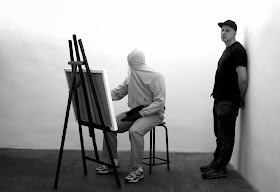"I first made tape casts as a child, wrapping the tape over pencils in
reverse and then back over
to seal it. I made them for fun, but I was scolded by my teacher not to "waste tape." In 2003, I
got interested in art and started experimenting with mediums and re-discovered this casting
process, applying it to larger objects and on myself. But my interest in art wasn’t so much
the sculpture itself but, rather, installation sculpture, using the object to affect the space around it."
to seal it. I made them for fun, but I was scolded by my teacher not to "waste tape." In 2003, I
got interested in art and started experimenting with mediums and re-discovered this casting
process, applying it to larger objects and on myself. But my interest in art wasn’t so much
the sculpture itself but, rather, installation sculpture, using the object to affect the space around it."
Disturbing, humorous, and enigmatic in equal measures. His first life-sized figure made from
tape was installed on the streets of Rio de Janeiro. That is now more than ten years ago.
Today, Jenkins’ tape sculptures appear in cities all over the world. Jenkins began 2006 to fill
the sculptures with paper or cement and dressed them to create hyper realistic sculptural
duplicates of himself
tape was installed on the streets of Rio de Janeiro. That is now more than ten years ago.
Today, Jenkins’ tape sculptures appear in cities all over the world. Jenkins began 2006 to fill
the sculptures with paper or cement and dressed them to create hyper realistic sculptural
duplicates of himself
/ Gleichermaßen verstörend, komisch und rätselhaft. Seine lebensgroßen Figuren aus
Klebeband wurden zum ersten Mal in den Straßen von Rio de Janeiro installiert. Das war vor
mehr als zehn Jahren. Heute sind die Jenkins-Figuren in aller Welt verbreitet. 2006 begann
Jenkins, die Skulpturen mit Papier und Zement zu füllen und zu bekleiden und
kreierte hyperrealistischen Doppelgänger von sich selbst
Klebeband wurden zum ersten Mal in den Straßen von Rio de Janeiro installiert. Das war vor
mehr als zehn Jahren. Heute sind die Jenkins-Figuren in aller Welt verbreitet. 2006 begann
Jenkins, die Skulpturen mit Papier und Zement zu füllen und zu bekleiden und
kreierte hyperrealistischen Doppelgänger von sich selbst







